Tent heaters are inherently dangerous. Anytime you bring heat into an enclosed space you are increasing the risk of fire, suffocation, and gas poisoning. That’s why it’s worth spending the extra time (and sometimes money) to make sure you get something that’s going to be as safe as possible.
As always, never sleep with any tent heater or use one unattended. Follow the manufacturer’s recommendations for each heater.
Best Heater For Tents: The Portable Buddy Mr. Heater Tent Heater
I made a video about the best tent heater as well as how it compared to 6 other heaters in my video, here:
By the way, as an Amazon Associate, I earn when buying qualified products through links on my site.
The Portable Buddy by Mr. Heater is the best overall indoor heater. Having tested 6 other gas tent heaters the Portable Buddy has minimal carbon monoxide emissions, tip detection, is stable and well constructed, has blow-out protection, and can warm up a tent in just a few minutes.
The indoor heater class isn’t that big, to be fair–since most companies are not willing to advertise that their heaters are for indoor use. Mr. Heater however takes the plunge.
Their indoor heaters (such as the Portable Buddy Heater), are certified to the ANSI Z21.103-2017 standard, which is for portable gas heaters for indoor/outdoor use.
You can buy yours on Amazon as I did, here:

The Portable Buddy Mr. Heater has some important features that make it so it can be used indoors under careful supervision. And Mr. Heater even recommends only to use it in emergency situations.
PORTABLE PROPANE HEATER FOR
On the front of the Mr. Heater Manual (see here)
RECREATIONAL AND
EMERGENCY INDOOR USE
Even though this heater is the safest indoor heater around, I found that the Portable Buddy heater can be extremely dangerous if you are not careful and it needs specific safety precautions. Follow all listed safety precautions you can find in Mr. Heater’s manual, and above all else, never sleep or use a gas heater unattended (as it says in the manual for good reason).
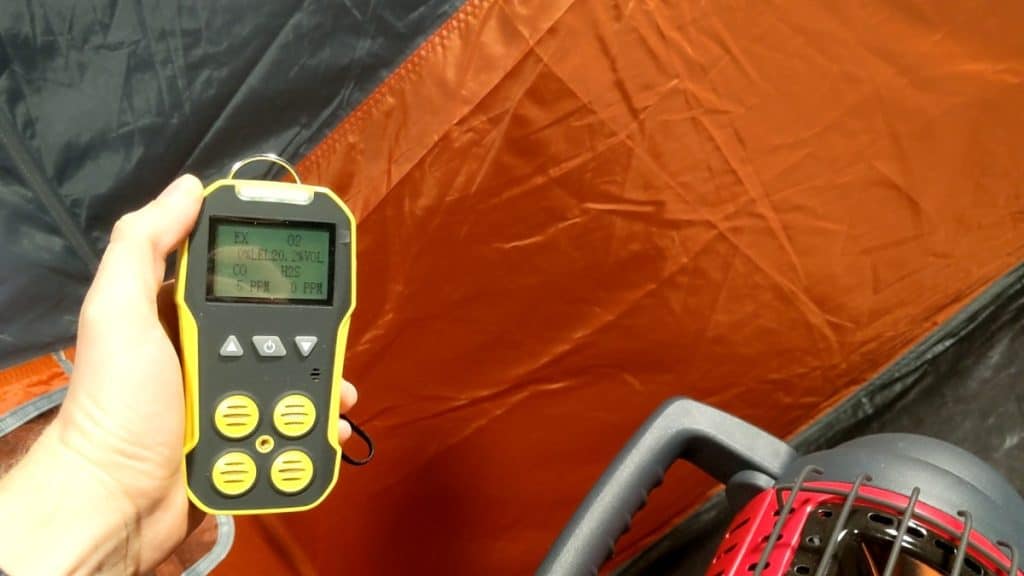
Safety Features Of The Portable Buddy
Here are some of the safety features that I personally tested and found to be great
- Tip Detection: The Portable Buddy will shut off the propane supply if you tip it 30-45 degrees (from my testing). If it falls forward it will still melt your tent floor, though, so definitely still be careful about that
- Patented Anti-Cross-Thread Technology: Perhaps an understated risk to using a gas heater is screwing in the propane bottle to the heater. If the threading is not perfect (and you accidentally cross thread), then you are setting yourself up for a gas leak. From the 7 gas heaters that I bought, the Mr. Heater brand heaters have a very stable screw-in making it safer to attach the gas than others.
- Heat Goes Where It’s Supposed To: This heater doesn’t toast the floor right in front of the heater. I was able to keep my hand on the floor right in front of the heater comfortably without any issues. The heater doesn’t leak heat to the sides either, it goes straight forward (and there is a significant amount of heat that goes up, but that is true of every heater)
- Blow-Out Detection: If the heating element (A ceramic tile with a bunch of holes in it you can see in the picture above) blows out, the gas will turn off. I used a flammable gas detector to check for leaking propane after I blew out the heating element and the detector got up to 10% before the blow-out detection kicked in and turned off the device. This isn’t something you should rely on, but it’s a great feature to have.
- Sturdy Stand: It’s a small thing that you might not think about, but the Portable Buddy is actually pretty stable on the ground. Some other heaters tip easily, and even though many heaters have a tip detector and will shut off if tipped, it’s nice to not be too worried about it all the time.
- Temperature Control: With the Portable Buddy you can adjust the temperature of the burn pretty well for whatever size tent you are using the unit in. You can’t use the Portable Buddy full blast in a small tent–but being able to adjust the temperature makes it possible.
This is a safety feature that I tested and I wasn’t impressed with.
- O2 Deprivation Sensor: The Portable Buddy supposedly has an O2 Deprivation Sensor which will turn off the heater if the O2% in the area is too low. I’m sure that it does have this sensor, but I did a test to see how much oxygen could be depleted before the sensor would turn off and I found that the O2 deprivation sensor is not sensitive enough to protect you from dangerous O2/carbon monoxide levels. So you should never count on this safety feature to help you.
How Long Does The Portable Buddy Last?
From my testing, the Portable Buddy lasted about 40 minutes on low and 1 3/4 to 2 hours on high for a single 1lb bottle of propane.
Mr. Heater themselves claims that the Portable Buddy will last 6 hours on low for a single 1lb bottle of propane.
I would guess that the Portable Buddy would last about 2 1/2 hours on the high-temperature setting, which if you are planning on using this unit for long periods of time, it might be in your best interest to buy an adapter and hook up to a 20lb propane tank.
Using a 20lb Propane Tank With Portable Buddy
The Portable Buddy heater comes with an attachment specifically made for a 1lb propane tank, but if you get the right adapter and hose you can hook it up to a 20lb propane tank.
Mr. Heater sells hose adapters specifically for this purpose. You can’t use any hose even if it fits because the hose is designed with some additional safety mechanisms to ensure gas flow. You can check out the hose here on Amazon.
How Warm Does the Portable Buddy Get? (I Did a Temperature Test)
Mr. Heater says that the Portable Buddy burns at 4000-9000 BTU depending on the temperature setting. I’m not a genius so I didn’t really have a great way to measure exactly how hot the unit burned. However, I did do a temperature test and found that for a 9×10 tent, the Portable Buddy warmed up the area 3 ft in front of the heater by 13 degrees Fahrenheit in 15 minutes.
I compared the Portable Buddy to other similar heaters and the Portable Buddy warmed up that area 3 ft in front of the heater by 5 degrees in 3 minutes and 20 seconds, which was the 2nd fastest for heaters of this size.
As far as what it’s like to be in a 9×10 tent with the Portable Buddy heater, you can feel the heat even if you’re 6-7 feet away and it definitely warms up the tent as a whole, which I can’t say for the smaller heaters I tested.
The Portable Buddy puts out a really decent amount of heat, but if you’re not careful you can burn through a 1lb propane bottle in less than 3 hours.
Does The Portable Buddy Need Batteries?
The Portable Buddy is completely propane powered, with a mechanical igniter, so there are no batteries necessary. The Portable Buddy also does not have a built-in fan to direct hot air.
To light the Portable Buddy you push a mechanical button that clicks a piezo igniter which lights the propane.
That’s one nice thing about the Portable Buddy. If you have no power or batteries, there’s no problem as long as you have propane.
Overall Summary
The Portable Buddy Heater is not perfect and it’s not perfectly safe, but it is the best in its class. Out of all the heaters I purchased, this is the heater I’m going to keep for myself. It’s stable, easy to use, and puts out a lot of heat.
Mr. Heater Little Buddy Tent Heater
The Little Buddy shares many of the same features as its bigger brother, the Portable Buddy, but it is much smaller. Rather than being an all-enclosed unit, the Little Buddy uses the propane bottle as a stand–it comes with a platform specifically for the propane bottle so it won’t tip over.
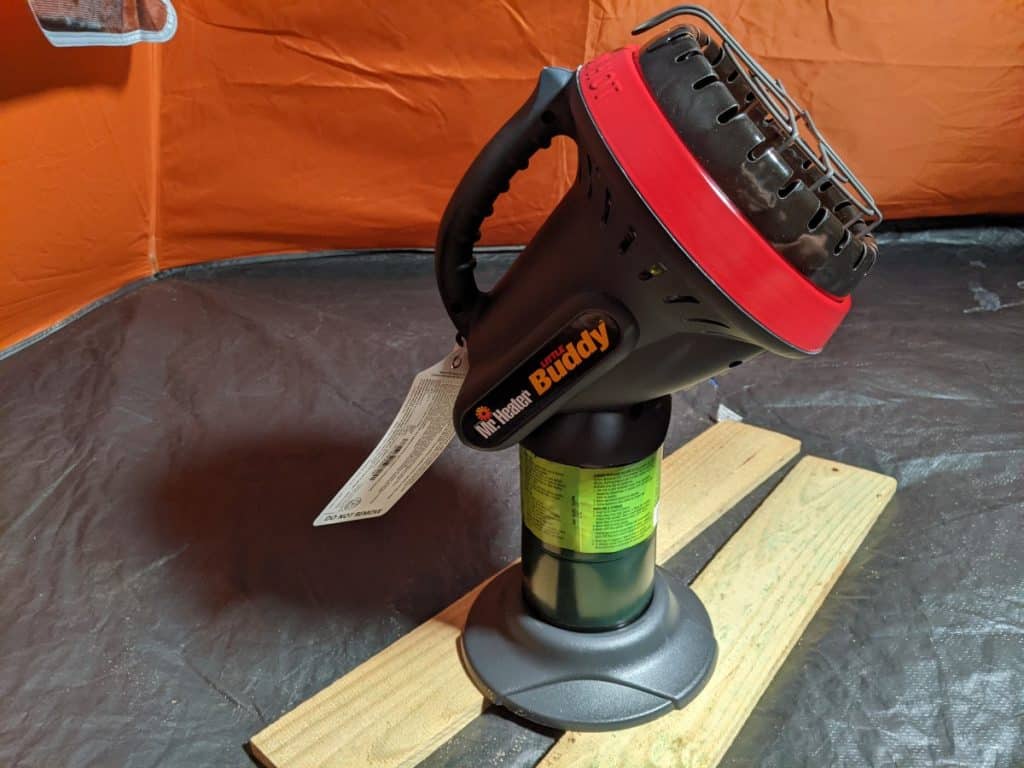
Safety Features Of the Little Buddy from Mr. Heater
As mentioned, the Little Buddy has almost all the same safety features as the Portable Buddy, I’ll list them here for your convenience, though, along with some things to take note of:
- Tip Detection: The Little Buddy will shut off the propane supply if you tip it 30-45 degrees (from my testing). The Little Buddy is definitely more tippy than its bigger Portable Buddy brother. It’s top heavy and the weight is distributed forward
- Patented Anti-Cross-Thread Technology
- Heat Goes Where It’s Supposed To
- Blow-Out Detection: I got a reading of about 12% of flammable gasses right above the Little Buddy when I blew out the flame. So it was on for about 15 seconds or so with no flame.
I also tested the O2 deprivation sensor and, like the Portable Buddy, does not turn off before it gets to dangerous O2 readings (below 19.5%)
Safety Concerns Of the Little Buddy
I wanted to mention a couple of my safety concerns with the Little Buddy so you can put caution where it’s necessary.
The Little Buddy Emits a Decent Amount of Carbon Monoxide
When I asked Mr. Heater if the Little Buddy emits Carbon Monoxide, they said “no, it’s not possible.” However, when testing with my gas detector I found that the Little Buddy emits from 7-11 ppm (not a dangerous amount if you are ventilated) when the unit is hot.
The Little Buddy also got up to 37 ppm while lighting. Since it’s only 37 ppm for a few seconds, it’s not considered dangerous, but it’s something to be aware of.
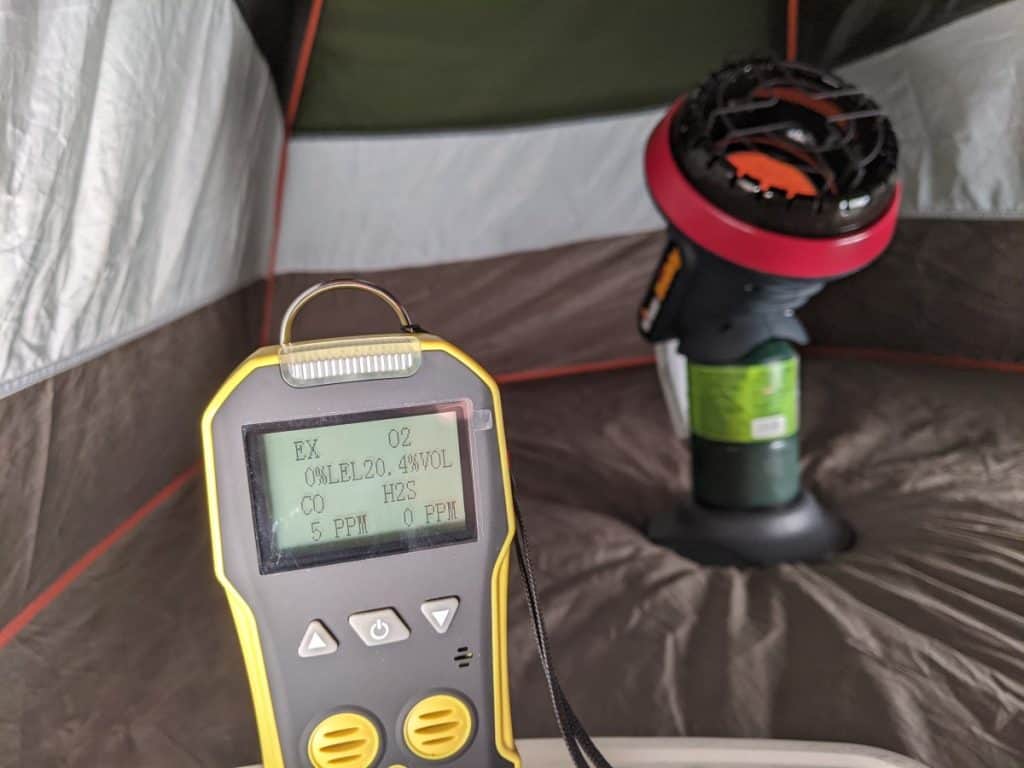
I did a lot of tests, and I replicated a low-ventilation scenario by not guying out the tent lines and partially obscuring the tent vent. In 15 minutes, the carbon monoxide in the tent raised to 5 PPM (considered safe and normal) while the oxygen dropped .5% (not a good sign).
Even though this is designed for small indoor spaces, you must have adequate ventilation. The Little Buddy, although it’s a smaller heater does emit CO and can deplete the oxygen in the tent. If you follow the manufacturer guidelines you’ll be okay.
The Little Buddy Is Tippy
The Little Buddy is blessed with a functional tip detector. If the tip detector is working properly, it will shut off if tipped over. In a well-ventilated tent, the most dangerous aspect of a heater is the fact that it can melt or ignite nearby objects.
However, if your heater tipped over, it’s not going to cool fast enough to not potentially ignite or melt your tent floor. This is true of all heaters, to be fair, but the Little Buddy is built in such a way to be fairly unstable, even when using its stand.
The Little Buddy is top and forward heavy. I did not feel comfortable using this on the tent floor without additional support from wooden planks. On the uneven ground, a gust of wind could knock this over easily.
How Long Does the Little Buddy From Mr. Heater Last?
From my testing, the Little Buddy lasted about 5 1/4 hours on a single 1lb tank of propane.
Mr. Heater advertises 5 1/2 hours of burn time–this definitely will vary from bottle to bottle, altitude, and how many times you light the unit, etc.
How Warm Does The Little Buddy Get?
From 3 feet away, the Little Buddy warmed up the area about 6 degrees (from 52.5 F to 58.1F) in 15 minutes. If you are sitting next to the heater you can definitely feel the heat, but it’s definitely not as powerful as the Portable Buddy.
In fact, it took 12 minutes to warm up the area 5F rather than 3 minutes (the Portable Buddy).
I noticed with the Little Buddy if you weren’t sitting 3 feet away from the heating element, you couldn’t feel it.
Does the Little Buddy Need Batteries To Operate?
Just like the Portable Buddy, the Little Buddy does not need batteries to operate–only propane. The Little Buddy is not compatible with a 20lb Propane Tank because it relies on a 1lb tank to be a stand for the heater.
Reasons For and Against Picking the Little Buddy Over the Portable Buddy
So, I think the Portable Buddy is the best choice for a tent heater because you can control the temperature on the Portable Buddy, and for a large tent (6-person+), the Little Buddy is only effective if you’re right in front of the heater.
However, there are some reasons why you might want the Little Buddy and I’ll list them here:
- If you are in a small tent. The Little Buddy puts off less heat than the Portable Buddy and takes up less space. In some circumstances a Portable Buddy won’t fit where a Little Buddy can. As with any gas heater, you must give 30-36 inches of clearance above the heater as a lot of heat rises from the heater. Follow the manufacturer instructions, here. Also, you must have a lot of ventilation in a small space. Stay on the safe side, here.
- If you are using the heater in your car. Unless you have a very large vehicle, the Little Buddy is your only option for a smaller vehicle. It’s so important to have a lot of ventilation. I had to have the windows cracked an entire palm’s width to prevent carbon monoxide buildup.
Best Gas Heater For a Car
Even though I saw there was a significant amount of CO buildup in a small vehicle like this, if I was to recommend the best gas heater for a vehicle I would recommend the Little Buddy.

The Little Buddy has very directional heat, so the seats actually didn’t get that warm, only the area right in front of the heater as well as above it.
Using a heater in your car is risky–having some sort of carbon monoxide alarm is important–but you shouldn’t rely on it. Furthermore, carbon dioxide and low oxygen levels are a risk as well. Having around 3 inches (about a palm’s width) of the window cracked open (and making sure to have all windows cracked open) is incredibly important. As always, don’t sleep with any heater on or use one unattended.
I found that just having an inch of ventilation on all the windows still led to carbon monoxide buildup. It might have taken a long time for it to be dangerous, but I found that with 3 inches of ventilation I did not see any CO buildup.
I also want to be clear that I think that it’s better to find other methods of staying warm in a car rather than using a heater. If you’re in a situation where you have no choice that’s one thing. But if you do, opt for insulating your car rather than using a heater in your car.
Martin CH3 Catalytic Heater
To be frank, the Martin CH3 is not rated for indoor use.
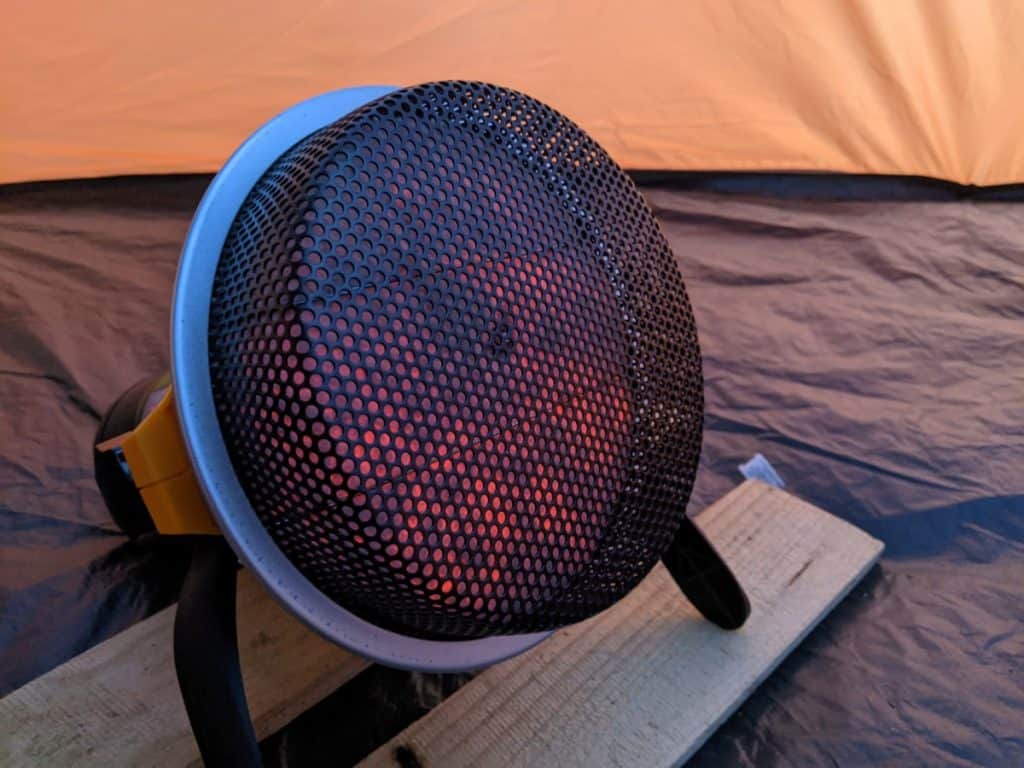
I tested the gas emissions of this device, and when fully ignited it actually puts off less carbon monoxide than the Little Buddy–however, carbon monoxide isn’t the only dangerous byproduct to worry about. I did feel like the area smelt funky–which I’m sure is due to the catalytic process.
In my opinion, if you are properly ventilated this is a heater you can use in an emergency situation. As always, I ultimately recommend following the manufacturer guidelines and not using this indoors. But for your benefit, I wanted to share what I think would work.
One awesome thing about the Martin CH3 (bought it here on Amazon) is that it’s flameless. You basically have to create a spark and open flame to get the catalytic process going, but once it’s going, it’s actually very difficult to stop.
With radiant heaters, you can blow out the heating element, but I could not do it with the Martin CH3. I even got a vacuum cleaner and tried to blow it out… but… I couldn’t do it. Shutting off the gas, of course, turns off the unit successfully.
This makes this heater ideal for windy conditions.
A flameless heater is definitely comforting in a cramped situation, but the grill grate still gets quite hot, so don’t let your guard down.
Safety Features of the Martin CH3
The biggest difference between the Martin CH3 and the Buddy line of heaters is that the Martin CH3 is a catalytic heater. Rather than burning propane to generate heat, a different chemical reaction is occurring using the propane as a catalyst. This means that the Martin CH3 is a flameless heater.
This has some interesting advantages and even drawbacks which I’ll mention later on.
- Flameless heater: A decent amount of heat without an open flame.
- Extremely Sturdy Design: The Martin CH3 uses the propane bottle itself as a 3rd leg. The short squat heater tripod is very stable. And although there is no anti-tip detection, unless you really bump into the thing it’s not going anywhere.
- Protective Grill Grate: the Martin CH3 has a grill grate that is actually pretty effective at keeping grass and other debris away from the heating element.
- Blow-out detection: Supposedly the Martin CH3 has blow-out detection where it will shut off if gas is running and there is no burn. To be honest I could not blow out the heater so I could not test this to see if that is true–however, it is a comfort that it is a thing.
Safety Concerns of the Martin CH3
Some safety concerns are to be mentioned beyond the regular care and attention you should give to any kind of heater.
The Martin CH3 Is a Bit Tricky to Light
The Martin CH3 has a Piezo Electric lighter. However, with other heaters, you can see a flame or pilot light ignite. With the Martin CH3, you can’t tell if your heater is completely ignited.
Complete ignition is important. I found that when the unit wasn’t completely ignited that it emitted propane into the air as well as a decent amount of carbon monoxide.
To safely ignite, you must follow the manufacturer’s instructions. They say to continuously press the ignite button for 40 seconds. I found that you can press the button until you stop getting the propane fwoosh (it will fwoosh several times) and the unit is getting considerably hot.
Because it’s kind of tricky, I recommend lighting it with plenty of ventilation and nowhere close to any other flame sources.
In a Well-Lit Location, You Can’t Tell The Heater Is Burning
Because there is no open flame, I noticed that when the lights were on, I couldn’t tell the unit was burning from a distance. This makes it easy to leave the heater running when you don’t want it to run. Always double-check this unit by ensuring the dial is set to off and that you hear no propane hissing.
No O2 Deprivation Sensor
I don’t think this is as huge a deal as people make it–those heaters that do have an O2 deprivation sensor still aren’t as sensitive as I think is safe. They will only really help in dire situations. So the fact the Martin CH3 doesn’t have one really cements its place as an outdoors-only heater, but it is still quite useful in a lot of situations.
How Long Does the Catalytic Martin CH3 Last?
Although the Martin CH3 marketing states that it lasts 7 hours on one 1lb propane bottle, I found through testing that the Martin CH3 lasted about 5 3/4 hours on high + 35 minutes on low.
If I had to guess, I would say the unit would last just under 6 1/2 hours on high. If you were to set it to low it’s very likely it would last longer than 7 hours, though.
How Warm Does the Catalytic Martin CH3 Get?
Even though the Martin CH3 is rated at a lower BTU than the Little Buddy, it was substantially warmer at 15 minutes of burning at about 61.3F at a 3ft distance.
It took the Martin CH3 7 minutes to raise the temperature 5 degrees.
Martin CH3 Summary
I really liked the Martin CH3… Even though its dial has an annoying sticker that wants to come off. To me it’s a perfect heater for an outdoor space–it puts off a decent amount of heat and won’t blow out and is stable on the ground.
How To Pick A Safe Tent Heater
I’ve given you the best heaters that I was able to find and buy, but perhaps you already have one or you found a deal that doesn’t have a heater from this list. Or, maybe you won’t buy one now but will later–in any case, you’re going to want to know exactly what features you’re looking for.
As a note, I talk about whether heaters are safe in a tent in the first place–I’d recommend opening my article up in another tab so you can see some of the risks.
Electric Heaters Have Their Own Risks
Electric heaters don’t emit gas in the same way propane heaters, do, but they still need good ventilation so you have enough oxygen.
Furthermore, the biggest risk of Electric heaters is your extension cord. If you’re at a campsite with electricity, you’ll need an extension cord to get the electricity into your tent.
This is a problem for several reasons.
- Electric Heaters specifically warn against using extension cords with the heater. This is because most extension cords are not suited to the high power draw of a heater. You can get an extension cord (like this one on Amazon) that is rated for higher electrical draw and that will certainly help, but it’s still a matter of adding more points of friction (the plugs, for example).
- If it’s wet, then this increases the risk of electric shock.
If you are dead set on the electric heater option, you should get a low-wattage heater, such as this one from Lasko (see on Amazon). This heater only draws 200w.
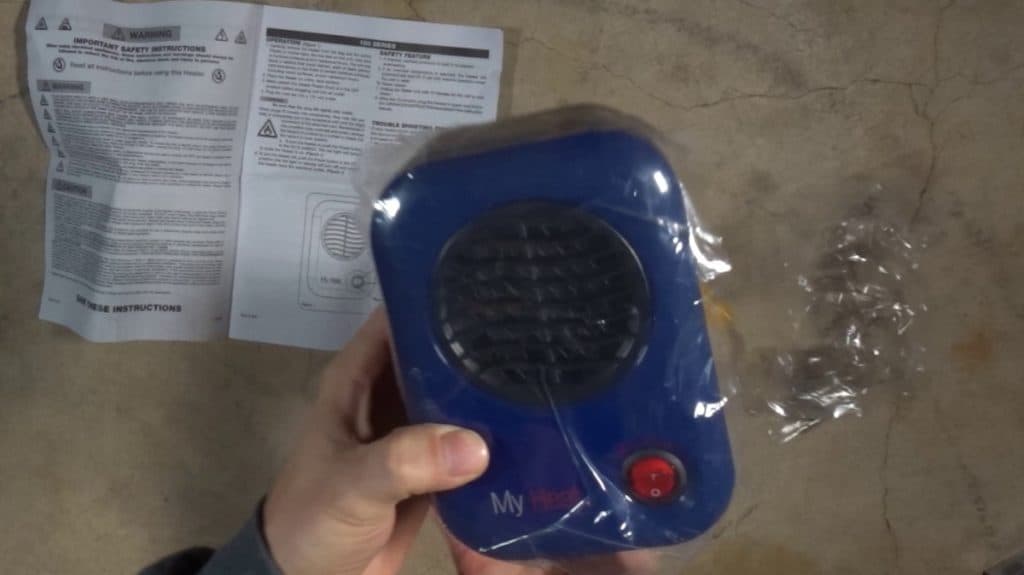
Just because it’s small doesn’t mean it’s perfectly safe, though. This heater has to be very close to you in order for you to be able to feel the heat, which means it’s riskier because that means it has to be closer to clothing and bedding, etc.
Also, even this low-wattage heater is not meant to be used with an extension cord (according to its safety documentation). Because of its low power draw, it could be used with a power bank such as this one (on Amazon as well).
Avoid An Open Flame
That means candles, gas stoves, lighters, open flame propane heaters–all of these shouldn’t be used indoors due to the open flame and because they take so much oxygen to burn.
Radiant heaters are still burning propane, but some disperse the propane so as to prevent an open flame. Mr. Heater and Flame King, for example, use radiant heaters that disperse the propane through a ceramic tile. They still have a burning pilot light, but it’s not a roaring flame like you get on a camp stove, for example.
There are some gas heaters that are called catalytic heaters, which use a chemical process to create heat from propane. These still can create dangerous gasses, so just because it’s a catalytic heater doesn’t mean it’s safe, but if you are going to use propane for a heater catalytic heaters are an option.
For Propane Heaters: Your Tent Heater Needs To Be Certified
There are many heater certifications, and only a few rating a heater for indoor use. One such certification is the ANSI Z21.103-2017 standard, which is for portable gas heaters for indoor/outdoor use.
Mr. Heater is one of the only brands that I was able to find that are up to this standard.
4.98 CSA Certification
This certification (you can see technical notes about it here) means that if the oxygen gets too low that the unit will shut off using what’s called an ODS. (Oxygen Depletion Sensor)
In my opinion, in an enclosed space this is an important feature. You should never rely on an O2 deprivation sensor to help you in a tough spot, but it’s one layer of protection that could save your life if all other safety precautions are missed. In an enclosed space, a lack of oxygen and too much carbon monoxide can make you sleepy and careless, which can be fatal.
Even with an oxygen depletion sensor, it’s important to never use a heater while you sleep in an enclosed space because your life is now resting on the proper functioning of that sensor. As I mentioned above, I’ve tested this feature, and the oxygen can get to a dangerous level even with the sensor.
Tip Detection
If your heater tips, it must shut off–we have an electric heater that does not shut off when tipped, so it’s not a feature that’s in every heater.
In a tent you have very limited space and the entire tent is made from fabric, so it’s very important that the heating element of the heater is not close to any walls, and therefore, if it tips it has to shut off or else it could start a fire.
Even with a properly working tip detector, it’s important to remember that the heating element is still off and you can melt or ignite your tent. It’s crucial to avoid a tip situation in the first place.
